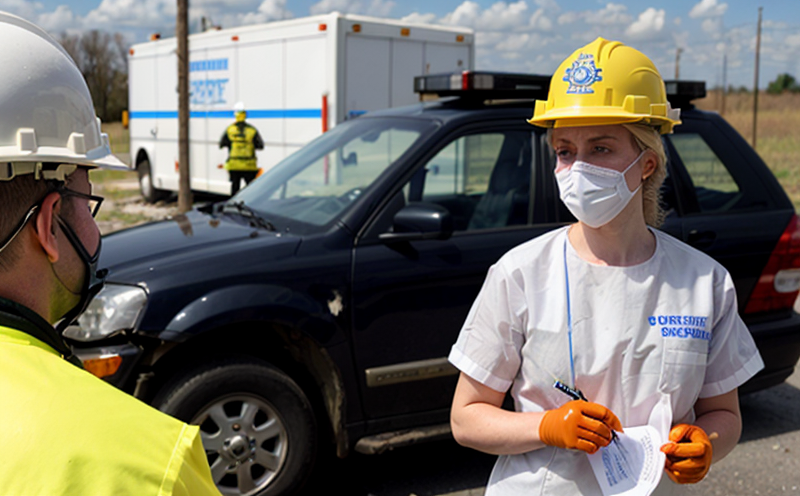ASTM E2625 Dosimetry for High-Energy Radiation in Accidents
The ASTM E2625 standard provides a comprehensive framework for the measurement and evaluation of high-energy radiation dosimetry, which is critical for accident dose assessment testing. This service ensures that radiation exposure is accurately quantified under emergency conditions, thereby aiding in rapid response and informed decision-making.
In the event of an industrial or accidental release involving high-energy radiation, accurate and reliable dosimetric data are essential for assessing potential health risks to individuals exposed to such environments. The ASTM E2625 standard supports these efforts by specifying methods to calibrate, validate, and use personal dosimeters designed to measure high-energy radiation doses.
The ASTM E2625 dosimetry service is particularly relevant in sectors where accidental releases of high-energy radiation could occur, such as nuclear power plants, research facilities, and industrial settings. The standard's application ensures that the collected data are consistent, reproducible, and meet international standards, thus enhancing trust and reliability.
The methodology involves several key steps: first, the selection of appropriate dosimeters capable of measuring high-energy radiation; second, the calibration of these instruments using known reference sources; third, deployment during the accident to collect dose information; fourth, retrieval and analysis of the data; and finally, reporting results that are actionable for emergency response teams.
The use of ASTM E2625 ensures that the dosimetry service adheres to best practices outlined in international standards. This standard is recognized globally and is widely used by regulatory bodies, industry professionals, and researchers. By employing this method, laboratories can provide accurate and reliable dosimetric data, which are crucial for effective accident management.
One of the primary challenges in high-energy radiation dosimetry lies in the variability of environmental conditions during accidents. ASTM E2625 addresses these challenges by providing a structured approach to dosimeter calibration and validation, ensuring that measurements remain accurate even under variable conditions. This standard also emphasizes the importance of continuous improvement through regular audits and updates based on new scientific findings.
The ASTM E2625 dosimetry service is particularly valuable for organizations involved in nuclear emergency response. By providing timely and accurate dosimetric data, this service enables quicker decision-making and more effective resource allocation during critical incidents. Additionally, the standard supports long-term planning by offering a robust framework for evaluating past events and improving future protocols.
In conclusion, ASTM E2625 Dosimetry for High-Energy Radiation in Accidents is an indispensable tool for ensuring that radiation exposure is accurately quantified and managed during emergencies. The service not only meets international standards but also enhances the reliability of dosimetric data, thereby supporting effective accident response and management.
Scope and Methodology
The ASTM E2625 standard defines a comprehensive scope for high-energy radiation dosimetry testing. This includes the selection, calibration, deployment, retrieval, and analysis of personal dosimeters designed to measure high-energy radiation doses.
- Selecting appropriate dosimeters: The service ensures that only instruments suitable for measuring high-energy radiation are used. These may include thermoluminescent dosimeters (TLDs), optically stimulated luminescence dosimeters (OSLDs), or other similar devices.
- Calibration of dosimeters: Before deployment, all dosimeters undergo rigorous calibration using known reference sources to ensure accuracy and consistency.
- Deployment during accidents: Dosimeters are strategically placed in areas where radiation exposure is expected to be highest. This ensures that the data collected are representative of actual exposure conditions.
- Data retrieval and analysis: After the accident, dosimeters are retrieved and their readings are analyzed to determine total absorbed dose.
The methodology outlined in ASTM E2625 is designed to provide accurate and reliable dosimetric data under emergency conditions. By following these steps, laboratories can ensure that the collected data meet international standards and are suitable for decision-making purposes.
It is important to note that the ASTM E2625 standard does not specify particular dosimeter models or brands; instead, it provides a framework that allows for flexibility in selecting appropriate instruments based on specific needs. This ensures that laboratories can tailor their testing methods to best suit the requirements of each unique situation.
Quality and Reliability Assurance
The ASTM E2625 dosimetry service is built around a series of quality and reliability assurance measures designed to maintain high standards in dosimetric testing. These measures include:
- Regular calibration checks: Dosimeters are regularly calibrated using known reference sources to ensure accuracy.
- Continuous monitoring: Laboratories continuously monitor the performance of their dosimeters to identify any issues early and address them promptly.
- Audits and reviews: Regular audits and reviews are conducted to assess compliance with ASTM E2625 standards and to identify areas for improvement.
- Data validation: All collected data undergo strict validation processes to ensure their accuracy and reliability.
These measures help maintain the integrity of the dosimetric data, ensuring that they are accurate, reliable, and actionable. By adhering to these quality assurance practices, laboratories can provide confidence in the results obtained from ASTM E2625 dosimetry testing.
International Acceptance and Recognition
The ASTM E2625 standard is widely recognized internationally and is used by regulatory bodies, industry professionals, and researchers. This service ensures that the collected data are consistent, reproducible, and meet international standards, thereby enhancing trust and reliability.
Numerous organizations have adopted ASTM E2625 as a benchmark for high-energy radiation dosimetry testing. By adhering to this standard, laboratories can provide accurate and reliable dosimetric data that are recognized globally. This not only enhances the credibility of the laboratory but also facilitates effective communication and collaboration with international partners.
The widespread acceptance of ASTM E2625 underscores its importance in ensuring consistent and reliable dosimetric testing across different regions and industries. By providing a standardized approach, this service supports global efforts to manage high-energy radiation exposure effectively.





